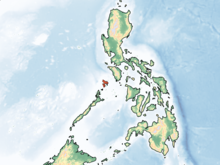Calamian deer
| Calamian deer | |
|---|---|

| |
| In the San Diego Zoo, California | |
| Scientific classification | |
| Domain: | Eukaryota |
| Kingdom: | Animalia |
| Phylum: | Chordata |
| Class: | Mammalia |
| Order: | Artiodactyla |
| Family: | Cervidae |
| Subfamily: | Cervinae |
| Genus: | Axis |
| Species: | A. calamianensis
|
| Binomial name | |
| Axis calamianensis (Heude, 1888)
| |

| |
| Synonyms | |
| |
The Calamian deer (Axis calamianensis), also known as Calamian hog deer,
Taxonomy
It is considered by some taxonomists to be in the genus
Behaviour and ecology
It is known as the "hog deer" because when it is fleeing from danger, it dashes through underbrush with its head down like a hog instead of jumping over barriers like other deer. These animals are crepuscular, meaning that they are active at sunrise and twilight. They rest during the warmer part of the day and then come out from the undergrowth to forage. Mainly solitary, they sometimes form small herds if left undisturbed. As with other deer species, Calamian deer are ruminants, meaning that they have four stomach chambers and chew cud. A soft, high-pitched, nasal call is their main vocalization. Their diet consist of shoots, twigs, and leaves.[5]
Characteristics
A typical height for males of 60–65 cm (24–26 in) has been reported. Weight can very usually from 79-110 pounds. Males have three-tined antlers.[5] Their fawns are not spotted at birth, which separates them from the best known western population of the Indian hog deer (A. porcinus). There are few natural predators except for birds of prey and pythons.
Fossil record
Fossils were found at
Using the work of Von den Driesch,
See also
- Bawean deer (A. kuhlii)
References
- ^ . Retrieved 12 November 2021.
- ^ "Appendices | CITES". cites.org. Retrieved 2022-01-14.
- ^ .
- ^ "Axis calamianensis". Mammal Diversity Database. American Society of Mammalogists. Retrieved 14 Aug 2022.
- ^ a b "Los Angeles Zoo and Botanical Gardens | Deer, Calamian". Los Angeles Zoo and Botanical Gardens. Archived from the original on 2018-03-11. Retrieved 2018-03-10.
- .
- ISBN 9781444391282.
- ISBN 978-9-4024-1106-5.
- ^ Von den Driesch, A. (1976). "A Guide to the Measurement of Animal Bones from Archaeological Sites". Peabody Museum of Archaeology and Ethnology. Cambridge, Massachusetts: Harvard University.
- ^ Heaney, L.; Balete, D.; Dolar, M. L.; Alcala, A.; Dans, A.; Gonzales, P.; Inlge, N.; Lepiten, M.; Oliver, W.; Ong, P.; Rickart, E.; Tabaranza, B.; Utzurrum, R. (1998). "A synopsis of the mammalian fauna of the Philippine Islands". Fieldiana Zoology (88).

